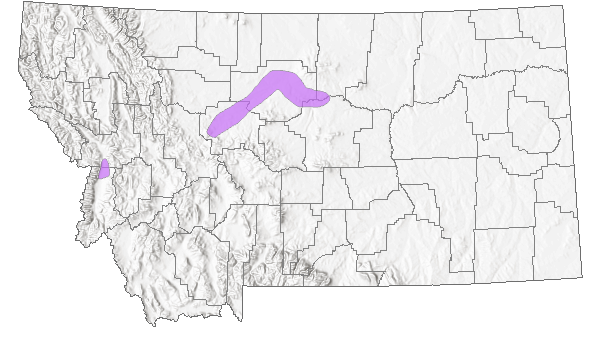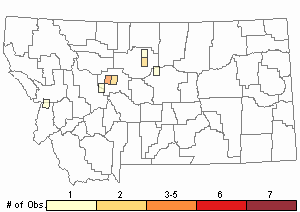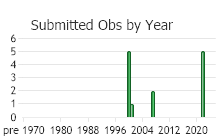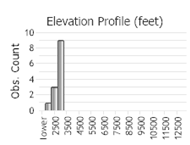View in other NatureServe Network Field Guides
NatureServe
Montana
Utah
Wyoming
Idaho
Wisconsin
British Columbia
South Carolina
Yukon
California
New York
Square-stem Monkeyflower - Mimulus ringens
State Rank Reason (see State Rank above)
Rare. Currently known from a few riparian sites along the Missouri River in central Montana. Additional survey data are needed.
- Details on Status Ranking and Review
Population Size
Score3 - Vey Small: Generally <2,000 individuals.
CommentAdditional surveys are needed.
Range Extent
Score2 - Regional or State Endemic or Small Montana Range: Generally restricted to an area <100,000 sq. miles (equivalent to 2/3 the size of Montana or less) or Montana contributes 50% or more of the species’ range or populations OR limited to 2-3 Sub-basins in Montana.
Area of Occupancy
Score2 - Low: Generally occurring in 4-10 Subwatersheds (6th Code HUC’s).
Environmental Specificity
Score1 - Moderate: Species is restricted to a specific habitat that is more widely distributed or to several restricted habitats and is typically dependent upon relatively unaltered, good-quality habitat (C Values of 5-7).
CommentSpecific habitat requirements uncertain.
Trends
ScoreNA - Rank factor not assessed.
Threats
ScoreNA - Rank factor not assessed.
Intrinsic Vulnerability
Score1 - Moderate Vulnerability: Specific biological attributes, unusual life history characteristics or limited reproductive potential makes the species susceptible to extirpation from stochastic events or other adverse impacts to its habitat and slow to recover.
Raw Conservation Status Score
Score
9 total points scored out of a possible 13 (Rarity factors only).
General Description
PLANTS: A mat-forming, rhizomatous perennial with 4-angled stems that grow from 20 to 100 cm tall. Stems are ascending to erect and either branched or simple. Plants are glabrous. Source: Lesica et al. 2012.
LEAVES: Leaves are simple, sessile, and arranged opposite on the stem. Leaf blades are lanceolate to oblanceolate with serrate margins and 2 to 8 cm long. Source: Lesica et al. 2012.
INFLORESCENCE: Showy purple flowers that grow on long stems (pedicels) from the upper leaf axils. Source: Giblin et al. [eds.] 2018; Lesica et al. 2012.
The specific epithet ringens is Latin for “gaping” referring to the open mouth appearance of the flowers (Runkle et al. 2009). Mimulus is derived from the Latin word mime, meaning “actor” or “mimic,” and the male diminutive -ulus (Merriam-Webster 2019). This is most likely referring to the mask-like appearance of the flowers. The common name of Monkeyflower is in reference to the funny shape of the flower.
Phenology
Square-stem Monkeyflower reaches its flowering period from April through June (Fraga in Jepson Flora Project 2018).
Diagnostic Characteristics
Montana has 5 native
Mimulus species with purplish flowers, of which 2 are perennial and 3 are annual plants. In Montana
Mimulus species have opposite, simple leaves, and in the axils of the upper leaves grow pairs of stemmed flowers. Flowers have 5-petals and 5-sepals, are bilaterally symmetrical and tubular.
Square-stem Monkeyflower-
Mimulus ringens*Habit: Plants are mat-forming, rhizomatous perennials, often more than 15 cm tall.
*Herbage: None (glabrous).
*Leaves: Sessile, lanceolate to oblanceolate, serrate, and 2-8 cm long.
*Flowers: The corolla is 20-27 mm long, purple, and bilabiate with a bearded palate.
*Capsule: The mature capsule is 10-12 mm long.
Lewis’ Monkeyflower-
Mimulus lewisii*Habit: Plants are rhizomatous perennials, often more than 15 cm tall.
*Herbage: Almost glabrous (glabrate) to glandular-pubescent.
*Leaves: Sessile to subsessile, lanceolate to ovate, serrate, and 1-7 cm long.
*Flowers: The corolla is 3-5 cm long, bilabiate, pink-purple or magenta with a yellow and purple-spotted palate.
*Capsule: The mature capsule is 12-16 mm long.
Dwarf Purple Monkeyflower-
Mimulus nanus*Habit: Planta are annual, often less than 10 cm tall.
*Herbage: Glandular-puberulent.
*Leaves: Petiolate below and sessile above, oblanceolate, entire, and 5 to 15 mm long.
*Flowers: The corolla is 1-2 cm long, magenta, and bilabiate with a yellow-spotted palate.
*Capsule: The mature capsule is 7-11 mm long.
North Idaho Monkeyflower-
Mimulus clivicola *Habit: Plants are annuals, often less than 10 cm tall.
*Herbage: Glandular-pubescent.
*Leaves: Sessile, oblong, entire, and about 1 cm long.
*Flowers: The corolla is 10-15 mm long, purple and bilabiate with unequal lobes and a yellow-spotted palate.
*Capsule: The mature capsule is 5-8 mm long and tubular.
Brewer's Monkeyflower-
Mimulus breweri *Habit: Plants are annuals, often less than 15 cm tall.
*Herbage: Stalked-glands (stipitate glandular).
*Leaves: Narrow blades (lanceolate) with entire margins (smooth), stemmed (petiolate), and 5-20 mm long.
*Flowers: The calyx is purplish. The corolla is 5-10 mm long, purple to red, and slightly bilabiate.
*Capsule: The mature capsule is 5-7 mm long.
Species Range
Montana Range
Range Descriptions

 Native
Native
Range Comments
Square-stem Monkeyflower can be found from Saskatchewan to Nova Scotia and south to Idaho, Colorado and Texas (Lesica et al. 2012).
Observations in Montana Natural Heritage Program Database
Number of Observations: 14
(Click on the following maps and charts to see full sized version)
Map Help and Descriptions
Relative Density

Recency



 (Observations spanning multiple months or years are excluded from time charts)
(Observations spanning multiple months or years are excluded from time charts)
Habitat
In Montana Square-stem Monkeyflower prefers to grow along streambanks in the plains of Montana (Lesica et al. 2012). It has been found along the Missouri River.
National Vegetation Classification System Groups Associated with this Species
Wetland and Riparian
Riparian and Wetland Forest
Riparian Shrubland
Wet Meadow and Marsh
Ecology
POLLINATIONLarge floral displays of many flowers attract more pollinator visits which do not necessarily lead to greater reproductive success for Square-stem Monkeyflower (Karron et al. 2012). Pollinators often probe multiple flowers in a display and since Square-stem Monkeyflower has the ability to self-fertilize, larger floral displays lead to greater rates of self-fertilization. Large floral displays are therefore negatively correlated with male reproductive success. Outcrossing rates depend on population density, floral display size, floral morphology, and the presence of competition for pollinators (Flanagan et al. 2010).
The presence of Purple Loosestrife (
Lythrum salicaria) populations may increase competition for pollinator visits thereby potentially reducing the reproductive success of nearby Square-stem Monkeyflower populations (Flanagan et al. 2010). Total pollinator visits to Square-stem Monkeyflower decreased along with conspecific pollen transfer when the pollen from this native species is transferred to the stigmas of Purple Loosestrife. This leads to a lower number of seeds per fruit of Square-stem Monkeyflower.
Potential and Known Pollinators:
The following animal species have been reported as pollinators of this plant species or its genus where their geographic ranges overlap:
Bombus vagans,
Bombus bifarius,
Bombus centralis,
Bombus flavifrons, and
Bombus pensylvanicus (Thorp et al. 1983, Colla and Dumesh 2010).
GERMINATION AND LIGHTWhile most seeds need only certain conditions of moisture, temperature, and air, Square-stem Monkeyflower also requires light in order to germinate (Hutchings 1932). In experiments where direct sunlight is diffused, germination is significantly reduced. This implies that while light alone is necessary, full, direct light is preferred. Square-stem Monkeyflower seeds exhibited a near 100 percent viability when exposed to these preferred conditions.
Reproductive Characteristics
FLOWERSThe mature flowers of Square-stem Monkeyflower are purple and bilabiate with a bearded palate and a corolla from 20 to 27 mm long (Lesica et al. 2012). The calyx is 10 to 16 mm long with acute, subequal teeth. Pedicels are usually about 2 times as long as the calyx.
FRUITThe mature fruit of Square-stem Monkeyflower are many-seeded, ellipsoidal capsules that are 10 to 12 mm long (Lesica et al. 2012).
LIFE CYCLESquare-stem Monkeyflower is a perennial plant (Lesica et al. 2012). Plants flower in late spring or early summer and flowers last for only half a day after opening with one to several flowers opening in a day (Karron et al. 2006). Square-stem Monkeyflower may also reproduce vegetatively (Lesica et al. 2012).
HYBRIDIZATIONThere is morphological and chemical evidence that where the ranges of
Mimulus ringens and
Mimulus alatus overlap hybrids can form (Windler et al. 1976). Hybrids have intermediate calyx lobe length and peduncle length between parents. The resulting hybrids may also backcross with
M. ringens.
Mimulus alatus is known to occur in portions of central, south-central, and eastern U.S. and in Ontario, Canada (
https://plants.usda.govaccessed on May 3, 2020).
Stewardship Responsibility
Threats or Limiting Factors
Competition for pollinators maybe be stronger where Purple Loosestrife (Lythrum salicaria) and Square-stem Monkeyflower are both present (Flanagan et al. 2010).
STATE THREAT SCORE REASON
Threat impact not assigned because threats are not documented. (MTNHP Threat Assessment 2021).
References
- Literature Cited AboveLegend:
 View Online Publication
View Online Publication Lesica, P., M.T. Lavin, and P.F. Stickney. 2012. Manual of Montana Vascular Plants. Fort Worth, TX: BRIT Press. viii + 771 p.
Lesica, P., M.T. Lavin, and P.F. Stickney. 2012. Manual of Montana Vascular Plants. Fort Worth, TX: BRIT Press. viii + 771 p. McGregor, R.L. (coordinator), T.M. Barkley, R.E. Brooks, and E.K. Schofield (eds). 1986. Flora of the Great Plains: Great Plains Flora Association. Lawrence, KS: Univ. Press Kansas. 1392 pp.
McGregor, R.L. (coordinator), T.M. Barkley, R.E. Brooks, and E.K. Schofield (eds). 1986. Flora of the Great Plains: Great Plains Flora Association. Lawrence, KS: Univ. Press Kansas. 1392 pp. MTNHP Threat Assessment. 2021. State Threat Score Assignment and Assessment of Reported Threats from 2006 to 2021 for State-listed Vascular Plants. Botany Program, Montana Natural Heritage Program, Helena, Montana.
MTNHP Threat Assessment. 2021. State Threat Score Assignment and Assessment of Reported Threats from 2006 to 2021 for State-listed Vascular Plants. Botany Program, Montana Natural Heritage Program, Helena, Montana.
- Additional ReferencesLegend:
 View Online Publication
View Online Publication
Do you know of a citation we're missing? Lesica, P., M.T. Lavin, and P.F. Stickney. 2022. Manual of Montana Vascular Plants, Second Edition. Fort Worth, TX: BRIT Press. viii + 779 p.
Lesica, P., M.T. Lavin, and P.F. Stickney. 2022. Manual of Montana Vascular Plants, Second Edition. Fort Worth, TX: BRIT Press. viii + 779 p.
- Web Search Engines for Articles on "Square-stem Monkeyflower"





